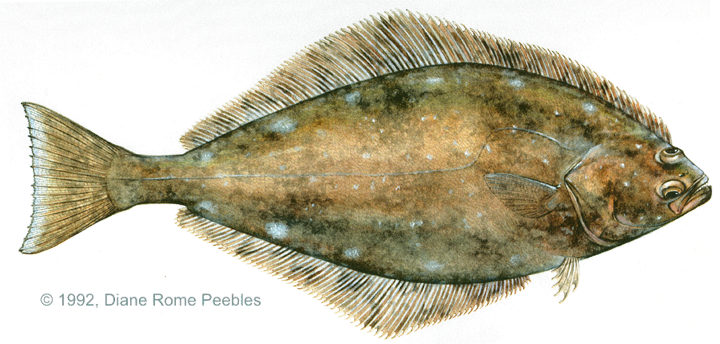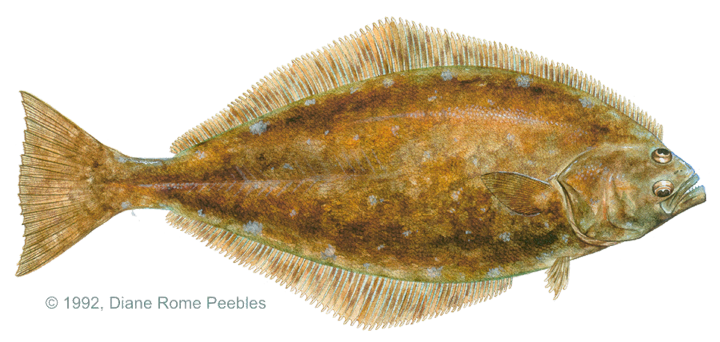Game Fish Identification Reference Guides
Halibut, Pacific
(Hippoglossus stenolepis)
(Hippoglossus stenolepis)

Schmidt, 1904; PLEURONECTIDAE FAMILY; also called northern halibut, right halibut, alabato
Occurs in cold waters of the North Pacific from the Bering Sea south to about Santa Rosa Island, California, on the American side and to northern Japan (including the Okhotsk Sea) on the Asian side. The Pacific halibut is highly migratory. Tagging operations have shown that some adult specimens travel 2,000 miles or more, though others appear to remain near the spawning grounds. In northern areas large halibut can be found in relatively shallow waters, but in the warmer southern portions of their range they may go as deep as 600 fathoms or more.
This is the largest Pacific flatfish and very much resembles the Atlantic halibut, Hippoglossus hippoglossus. The teeth are strong and equally well developed on both sides of the jaws. Coloration is uniformly dark brown or gray on the top side (often with small, lighter spots), and white and relatively featureless on the blind side.
Females grow to weights of over 470 lb (213 kg), live to a maximum age of 35 45 years and may attain a length of 9 ft (3 m). By comparison, males probably do not exceed 40 lb (18 kg) or 55 in (140 cm), and their maximum life expectancy appears to be about 25 years. The females are more numerous than the males and grow faster, except during the early stages of development.
The young feed primarily on crustaceans. Adults are piscivorous but will consume large crustaceans, squid, and other mollusks. Stomach contents indicate that large halibut feed in midwater as well as near the bottom. They can be caught while drift fishing on the bottom with heavy tackle, using baits like cod, herring, squid, mackerel or smaller flatfishes
Occurs in cold waters of the North Pacific from the Bering Sea south to about Santa Rosa Island, California, on the American side and to northern Japan (including the Okhotsk Sea) on the Asian side. The Pacific halibut is highly migratory. Tagging operations have shown that some adult specimens travel 2,000 miles or more, though others appear to remain near the spawning grounds. In northern areas large halibut can be found in relatively shallow waters, but in the warmer southern portions of their range they may go as deep as 600 fathoms or more.
This is the largest Pacific flatfish and very much resembles the Atlantic halibut, Hippoglossus hippoglossus. The teeth are strong and equally well developed on both sides of the jaws. Coloration is uniformly dark brown or gray on the top side (often with small, lighter spots), and white and relatively featureless on the blind side.
Females grow to weights of over 470 lb (213 kg), live to a maximum age of 35 45 years and may attain a length of 9 ft (3 m). By comparison, males probably do not exceed 40 lb (18 kg) or 55 in (140 cm), and their maximum life expectancy appears to be about 25 years. The females are more numerous than the males and grow faster, except during the early stages of development.
The young feed primarily on crustaceans. Adults are piscivorous but will consume large crustaceans, squid, and other mollusks. Stomach contents indicate that large halibut feed in midwater as well as near the bottom. They can be caught while drift fishing on the bottom with heavy tackle, using baits like cod, herring, squid, mackerel or smaller flatfishes













